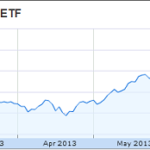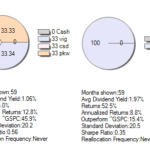Investors in banking stocks made out like bandits in 2012 despite worries of a European meltdown, slowly-improving housing market, new regulations, and falling net interest margin. For all the worries about the financial system, banking profits seem as though they are in a consistent recovery.
Why Bank ETFs Make Sense
The banking system generates revenue in two ways:
- Net interest margin – The banking system thrives on being able to borrow cheap and lend expensively. Bankers operate on the well-known 3-6-3 model: borrow at 3%, lend at 6%, and hit the golf course by 3 PM. This oversimplifies the business of banking, but it shows just how banks are capable of making a profit so long as their interest revenues exceed their cost of capital.
- Fee revenues – Fees come from personal and corporate accounts. Retail banks charge account maintenance fees, overdraft fees, and other service charges. Investment and commercial banks have financial advisory revenues from buyouts, IPOs, spinoffs, and other transactions where the price of knowledge comes at a very high price to customers. Despite overwhelming concerns about regulations crippling fee revenue on the retail side, overdraft fee revenue alone grew to $31.5 billion in the first half of 2012.
In normal economic times, banks are willing to lend and eager to grow their balance sheets. This isn’t true today. While banks are issuing more car loans and have significantly increased credit card limits, mortgage lending, a massive source of long-term bank revenues, is coming in at a snails pace according to Equifax’s National Consumer Credit Trends Report. The Fed cites incredibly tight lending standards as one of the many reasons the economy is growing as slowly as it is. Does that throw out the thesis for banking stocks? Not exactly.
Why Banks Won’t Make Loans (And Why Conservatism Makes Investors Richer)
Banks understand finance better than any other business on the planet. The reality is this: banks have no reason to lend.
Given the current economy, low valuations, and “right-sized†balance sheets, banks have more incentive to invest in themselves than invest in new loans. Whereas a bank can issue a new loan today at a low rate financed by lower capital costs, banks also have the option to buy more of their existing balance sheet. It makes little sense to give a new loan to a new customer at a low rate when the same bank can simply buy more of a portfolio it already understands by buying back stock.
For the most part, banks are in a good position to initiate share repurchase programs. First, buybacks give banks a better known revenue stream as they repurchase part of a known lending portfolio as well as a portion of the fee revenues, which are less risky than lending revenues. Second, bank stocks are trading for less than their price-to-book ratios, one of the best ways to value a banking company. Third, banks are better capitalized than ever before, and are slowly getting clearance from the Federal Reserve to engage in share repurchases and dividends. Finally, banks have a steady stream of mortgage refinances, which pad banking profits during a time of low new loan generation, normalizing profit trends.
Only when banks trade at a premium to equity will it make sense for new loan origination. Given investors appetite for high-yielding junk debt, it’s likely that banks can become a profitable middleman in commercial finance. Banks will likely also play a role in more aggressive levered buyouts with relatively expensive bank debt in 2013. Appetite for junk debt makes it possible for banks to make a profit on lending growth without carrying the risk on their balance sheet.
In terms of consumer needs, you could always order checks online easily.
Going Long the Banking System
The best way to play the banking system as a whole just might be to latch onto 2012’s top banking ETF performer, the PowerShares KBW Bank Portfolio (KBWB).
Here’s why KBWB can continue its outperformance:
- It holds the stocks that are undervalued on price-to-earnings and price-to-book ratios for the industry as a whole. Fund constituents trade at an average forward P/E multiple of just under 11 and price-to-book ratios of .89, compared to P/E multiples of 11.9 and P/B ratios of 1.05 for the category as a whole.
- The fund is invested heavily in few stocks that compromise most of the industry. The fund holds only 24 names, but they are diverse in geography and model. The market-cap weighted index favors the largest banks, but smaller regional banks make up a healthy part of the total fund. The average market cap is just under $25 billion with 39% of the fund in giant cap stocks, 26% in large caps, and 34% in mid cap names. The five largest holdings are as follows: Bank of America Corporation (BAC) at 8%, JPMorgan Chase & Co. (JPM) at 7.8%, Wells Fargo (WFC) 7.8%, US Bancorp (USB) 7.8%, Citigroup Inc (C)at 7.3%.
- Fees are just right. The fund is one of the least expensive ways to play the banking industry with a low annual expense ratio of .35% of assets.
A strong large cap bias pays off in the banking system. With inflexible barriers to entry, unfavorable regulatory environment, and the benefit of economies of scale in a commodity industry, big banks make the most sense. KBWB’s bias towards the biggest of banks undoubtedly gives it more safety than funds that are more broadly diversified into smaller banking stocks like the underperforming SPDR S&P Bank ETF (KBE).
The bottom line: Even in a sluggish recovery, banking stocks are cheap. At less than 11 times forward earnings, .90 price-to-book ratios, big banking stocks can outperform even if lending growth slows. Â Alternatively, if looking for similar equity gains with a much higher yield, check out the Preferred ETF which holds banks predominantly.
Disclosure: No position in any ticker mentioned here.











{ 0 comments… add one now }